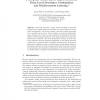Free Online Productivity Tools
i2Speak
i2Symbol
i2OCR
iTex2Img
iWeb2Print
iWeb2Shot
i2Type
iPdf2Split
iPdf2Merge
i2Bopomofo
i2Arabic
i2Style
i2Image
i2PDF
iLatex2Rtf
Sci2ools
SCIA
2005
Springer
2005
Springer
Perception-Action Based Object Detection from Local Descriptor Combination and Reinforcement Learning
This work proposes to learn visual encodings of attention patterns that enables sequential attention for object detection in real world environments. The system embeds a saccadic decision procedure in a cascaded process where visual evidence is probed at informative image locations. It is based on the extraction of information theoretic saliency by determining informative local image descriptors that provide selected foci of interest. The local information in terms of code book vector responses and the geometric information in the shift of attention contribute to recognition states of a Markov decision process. A Q-learner performs then performs search on useful actions towards salient locations, developing a strategy of action sequences directed in state space towards the optimization of information maximization. The method is evaluated in outdoor object recognition and demonstrates efficient performance.
| Added | 28 Jun 2010 |
| Updated | 28 Jun 2010 |
| Type | Conference |
| Year | 2005 |
| Where | SCIA |
| Authors | Lucas Paletta, Gerald Fritz, Christin Seifert |
Comments (0)

